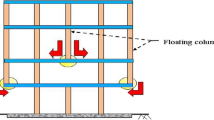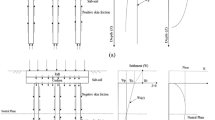Abstract
In recent decades, many researchers have focused their attention on seismic evaluation and vulnerability of structures before and after the earthquakes. As recognizing the structure condition after an earthquake is of vital importance, the capability of enduring future earthquakes and continuous serviceability through estimating structural damage is defined using the damage index. In the present research, the seismic resilience assessment before and after strengthening with FRP has been accomplished for low-rise, mid-rise and high-rise buildings with Reinforced Concrete (RC) moment resisting frames in the near-field sites. In this respect, use has been made of nonlinear incremental dynamic analysis with 104 seismic accelerometer records corresponding to 4 different soil types within the near-field sites. Also the results of vulnerability and seismic resilience curves after strengthening with Fiber Reinforced Polymer (FRP) are presented for the 3, 6 and 9-story buildings. The results obtained in the present research well depict that retrofit of RC moment resisting frames with FRP could increase their resilience. The results of the research clearly show that in the moment resisting frames at lower accelerations (about 0.2 g), the vulnerability of mid-rise and high-rise buildings is much higher than that of the low-rise buildings. But there is no significant difference between the mid-rise and high-rise buildings. By increase of the site acceleration, the vulnerability of mid-rise and high-rise buildings would significantly increase with respect to the low-rise buildings, but its severity would decrease with respect to lower accelerations. In other words, by increase of the earthquake acceleration, the percentage of vulnerability in the 6-story and higher buildings would approach that of the 3-story buildings. The retrofitted structure with FRP has a higher resilience at all the levels with respect to the existing structure. But the advantage of strengthening varies in different conditions and with different number of stories and soil types.



















Similar content being viewed by others
Data Availability
No datasets were generated or analysed during the current study.
Change history
31 May 2024
A Correction to this paper has been published: https://doi.org/10.1007/s40996-024-01485-8
References
Bertero VV (1977) Strength and deformation capacities of buildings under extreme environments. In: Pister KS (ed) Structural engineering and structural mechanics. Prentice Hall, Englewood Cliffs, pp 211–215
BHRC (Building and Housing Research Center) (2014) Iranian Code of Practice for Seismic Resistant Design of Buildings. Standard No. 2800, 4th edition. BHRC: Tehran. (In Persian)
Chaharbarj E, Nazmfar G, Atta. (2018) Assessing the physical resilience of the city against possible earthquakes; case example: district 1 of Tehran Municipality. Phys Dev Plan 4(4):11–26 (in Persian)
Department of Planning and Strategic Supervision (2006) Criteria guide the design and implementation of concrete improvements to existing buildings using reinforced materials FRP. Issue 345 (in Persian)
Hajizadeh O, Javaherzadeh S (2014). "Record selection for nonlinear seismic analysis of structures according to soil type." The article presented in the national conference on the use of technology and new technologies in design, calculation and implementation in civil engineering, architecture and urban planning. Azad University, Shabestar Islamic Branch. 8(4)
HAZUS–MH MR5 (2014) Multi-hazard loss estimation methodology–earthquake model. Department of Homeland Security, Washington. http://www.fema.gov/media-library/assets/documents/20469. Accessed 14 Jul 14
Holling CS (1973) Resilience and stability of ecological systems. Annu Rev Ecol Syst 4(1):1–23
Luco N, Cornell CA (1998) Effects of random connection fractures on demands and reliability for a 3-story pre- Northridge SMRF structure. In: Proceedings of the 6th U.S. national conference on earthquake engineering. EERI, El Cerrito, Seattle, vol 244, pp 1–12
Luco N, Cornell CA (2000) Effects of connection fractures on SMRF seismic drift demands. ASCE J Struct Eng 126:127–136
Manyena SB (2006) The concept of resilience revisited. Disasters 30(4):434–450
Omidian P, Safari (2019) Generation of failure curves to evaluate the seismic vulnerability of reinforced concrete buildings with shape memory alloy in regular, high irregularity and severe torsional irregularity states. Struct Constr Eng 6(Special Issue 4), 125–146
Omidian P, Khaji N (2022) A multi-objective optimization framework for seismic resilience enhancement of typical existing RC buildings. J Build Eng 52:104361
Pacific earthquake engineering research center (PEER) (2023) PEER NGA database. https://www.ngawest2.berkeley.edu
Salgado RA, Apul D, Guner S (2020) Life cycle assessment of seismic retrofit alternatives for reinforced concrete frame buildings. J Build Eng 28:101064
SeismoStruct (2022) A computer program for static and dynamic nonlinear analysis of framed structures, SeismoSoft’s Ltd. https://www.seismosoft.com/
Sheikh SA, Yau G (2002) Seismic behavior of concrete columns confined with steel and fiber-reinforced polymers. Struct J 99(1):72–80
Shome N, Cornel CA (1999) Probabilistic seismic demand analysis of nonlinear structures. PhD dissertation, Stanford University
Shooshtari A, Bayat M (2010) Investigation of ductility and seismic behavior of RC with confined members with FRP. In: 5th national civil engineering conference (in Persian)
Smith ST, Teng JG (2002) FRP-strengthened RC beams. I: review of debonding strength models. Eng Struct 24(4):385–395
Tavakolizade MR, Ghods AS (2009) A review of the regulations for strengthening concrete members with FRP sheets (ACI 440.2R-08)., Mashhad, Iran (In Persian)
Timmerman P (1981) Vulnerability, resilience and the collapse of society: a review of models and possible climatic applications. University of Toronto, Institute for Environmental Studies
Turgay T, Polat Z, Koksal HO, Doran B, Karakoç C (2010) Compressive behavior of large-scale square reinforced concrete columns confined with carbon fiber reinforced polymer jackets. Mater Des 31(1):357–364
Vamvatsikos D, Cornell CA (2001) Incremental Dynamics Analysis. Wiley J Struct Eng 126:127–136
Vamvatsikos D, Cornell CA (2002) Incremental dynamic analysis. Earthq Eng Struct Dyn 31(3):491–514
Author information
Authors and Affiliations
Contributions
Mr. Barjouie has writen the manuscript. Dr. Saffari has revised the paper.
Corresponding author
Ethics declarations
Competing interests
The authors declare no competing interests.
Rights and permissions
Springer Nature or its licensor (e.g. a society or other partner) holds exclusive rights to this article under a publishing agreement with the author(s) or other rightsholder(s); author self-archiving of the accepted manuscript version of this article is solely governed by the terms of such publishing agreement and applicable law.
About this article
Cite this article
Pour, H.B.R., Saffari, H. Relationships for Evaluating the Seismic Resilience Index of Reinforced Concrete Buildings Built Up with FRP Lying on Different Soil Types under Near-Field Earthquakes. Iran J Sci Technol Trans Civ Eng (2024). https://doi.org/10.1007/s40996-024-01404-x
Received:
Accepted:
Published:
DOI: https://doi.org/10.1007/s40996-024-01404-x




